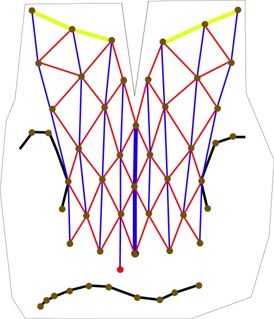- Photophores (head)
- Compound photophores (Type 1b):
 Click on an image to view larger version & data in a new window
Click on an image to view larger version & data in a new window
Figure. Various views of the head photophores of H. inermis, 49 mm ML, USNM # 816306, preserved. Right photographs - Show one or more of the basic photophore groups, from different views, with superimposed lines and dots to emphasize the photophore groups. Left photographs - Show the same pictures without superimposed lines and dots so that the photophores can be seen without obstruction. The superimposed lines are formed by first placing white dots over the pigmented, photogenic cups of all photophore in a particular group. The dots are then joined by a line of the appropriate color. Photographs by R. Young.
-
 Click on an image to view larger version & data in a new window
Click on an image to view larger version & data in a new window- Basal Arm IV Row with 3 photophores. Medial photophore separated by 1 photophore from anterior photophore of Midline Series.
- Midline Series with 3 photophores.
- Right Eyelid Series with 17 photophores (15-17 according to Taki, 1964).
- Left Eyelid Series with 6 photophores.
- 2° Right Eyelid Series with 8 photophores.
- 2° Left Eyelid Series with 7 photophores.
- Ventral Matrix with 36 photophores including an asymmetrically placed dangling, rogue photophore (colored red in illustration), and 9 longitudinal (blue) series. Attachment to 2° Eyelid Series at 2° eyelid photophores no. 2 either side.
- Ventral Matrix photophores do not align in transverse rows.
- Right basal series absent.
- Left basal series apparently with two small photophores.
- Basal row with 10 photophores smoothly aligned (i.e. without a sawtooth).
- Right Accessory Series with 2 photophores (see below).
- Left Accessory Series with 3 photophores (see below).
- Simple photophores (round, black dots):
- Arrangement as illustrated.
- Large, simple photophores on dorsal surface of head absent.
- Small, simple photophores not easy to recognize and may be variable.
- Compound photophores (Type 1b):
- Photophores (mantle)
- Dorsal surface of the mantle with about 6 diagonal rows of photophores with the medial ones smaller (drawing on right).
- The ventral mantle has photophores arranged in about 10 diagonal rows.
- The ventral mantle margin has 14 photophores.
- Tentacle
- Club length about 20% of ML.
- Carpal locking apparatus with 5-7 suckers and 4 pads.
- Suckers on manus in 5-6 irregular series.
- Largest suckers of the manus about twice the diameter of the small marginal suckers.
- Large suckers of manus with 23 slender, pointed teeth.
- Suckers on dactylus in 4-6 series.
According to Taki (1964) the teeth on the distal margin are more slender and taller than those on the proximal margin. Taki's drawing (below left) clearly shows thicker teeth on the proximal margin. The photograph below of a large sucker from the damaged club of our specimen, shows the same features.
- Arms
- Length 1.2-1.5 times ML.
- Arm formula: 2>1>3>4 or 2>3>1>4.
- Suckers of arms IV about half the diameter as those of the other arms.
- Suckers of all arms with smooth inner rings (drawing on right).
- Web
- Inner web low to vestigial.
- Inner web low to vestigial.
- Fins
- Length 45-60% of ML.
- Width 70-90% of ML.
Comments
This description of the head photophores is based on 2 squid in the NMNH that were identified by N. Voss as H. inermis and included in her description of the species in Voss et al. (1998). Since these authors have examined the type specimens and since the NMNH specimens are from the type locality, we are confident the identification is correct. The remaining description is taken from Taki (1964) and Voss, et al. (1998).
On the head of one of the squid we found an "extra photophore" (i.e., a photophore that doesn't have a counterpart on the opposite side of the squid) at the base of left arm IV. This photophore is highlighted by a light yellow circle in the photograph showing the ventral view of the head. Since this photophore is absent from our other specimen, we assume that it is an aberrant photophore and, therefore, excluded it from the analysis.











 Go to quick links
Go to quick search
Go to navigation for this section of the ToL site
Go to detailed links for the ToL site
Go to quick links
Go to quick search
Go to navigation for this section of the ToL site
Go to detailed links for the ToL site